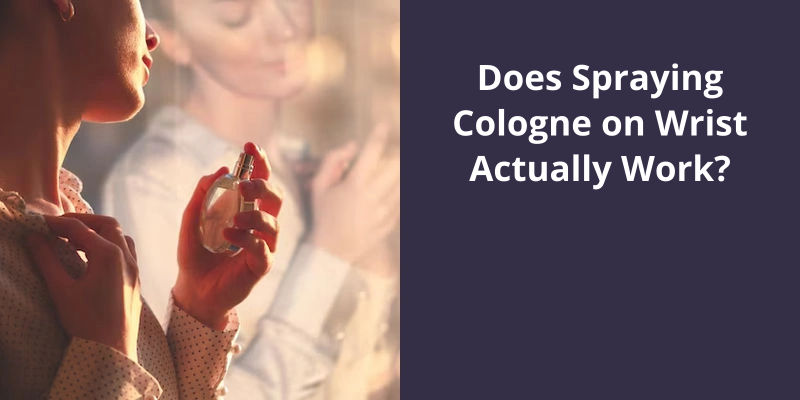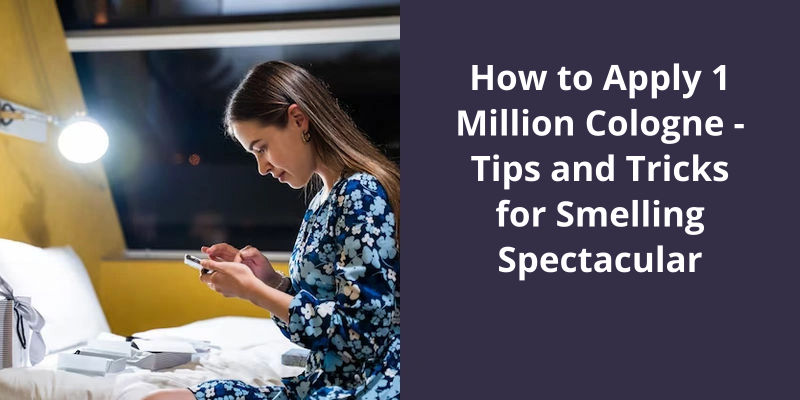Spraying cologne on your wrist does actually work because it is a pulse point where your body naturally produces heat. The heat from these pulse points helps to project the scent into the air around you. However, to get the best results, don’t rub your wrists together after application because this can break down the fragrance structure and alter its scent. Simply spray the cologne, let it dry naturally, and enjoy the scent throughout the day. Besides the wrists, you can also consider other pulse points like your neck or behind your ears.

What Happens When You Spray Perfume on Your Wrist?
Spraying perfume on your wrists is a popular practice among fragrance enthusiasts. The idea behind this technique is that the warmth of the pulse points on your wrists helps to intensify and project the fragrance throughout the day.
They assume that rubbing the perfume into the skin will help release the fragrance and make it last longer. Unfortunately, the reality is quite the opposite.
Rubbing your wrists together after applying perfume can actually dull the top notes of the fragrance and accelerate it’s evaporation. The friction caused by rubbing generates heat, which can alter the chemical composition of the scent and alter it’s intended scent profile. This can lead to the fragrance developing differently on your skin than initially intended by the perfumer.
Since alcohol carries the fragrance oils and helps them evaporate gradually, accelerating it’s evaporation can drastically shorten the lifespan of the scent on your skin.
To ensure you get the most out of your fragrance, experts suggest a different application technique. This way, the fragrance will have a chance to develop properly and last longer throughout the day.
Tips for Layering Perfumes to Create a Unique and Long-Lasting Scent
- Start with a light fragrance as the base. Choose a scent that’s fresh and clean.
- Add a floral fragrance to create depth. Look for notes like rose or jasmine.
- Layer in a warm and spicy fragrance. This can be a perfume with notes of vanilla or cinnamon.
- Consider adding a citrus scent for a refreshing twist. Look for perfumes with notes of lemon or grapefruit.
- Finish with a touch of musk or amber to add complexity and longevity to your scent.
- Remember to spray each fragrance lightly and let it dry before applying the next one.
- Experiment with different combinations and proportions to find your perfect layered scent.
- Don’t be afraid to mix and match different perfume brands to create a unique fragrance.
- Layering perfumes is a great way to customize your scent and make it last all day.
Finding the ideal location to apply cologne can make all the difference when it comes to it’s longevity and fragrance projection. To optimize the effectiveness of your chosen scent, it’s recommended to target your pulse points. These areas, such as the inner wrist and neck, are warmer spots on the body where blood flows, ensuring that the cologne blends with your natural scent and projects it more prominently.
Where Is the Best Place to Put Cologne on Your Body?
One of the most common questions when it comes to cologne is where to apply it on your body for the best effect. The key is to target your pulse points, which are essentially the warmer spots on your body where the blood flows. These areas are perfect for cologne application because they mix with your natural scent and enhance the projection of the fragrance.
The inner wrists are one of the most popular pulse points for spraying cologne. This is because the vein in the wrist is close to the surface, generating heat that amplifies the scent. It’s recommended to spray the cologne from a distance of about three to six inches away from the skin, allowing it to settle and blend with your natural body chemistry.
In addition to the wrists and neck, you can also apply cologne behind your ears. This area is a pulse point as well, and also generates heat that helps the fragrance to develop. Some people also prefer to spray cologne on their chest or the back of their knees to make the scent last longer throughout the day.
Remember, the key isn’t to drown yourself in cologne but rather to have a subtle and pleasant scent. Therefore, it’s crucial to find the right balance when spraying cologne on your pulse points. Experiment with the number of sprays and find what works best for you to achieve an alluring and enticing fragrance that lasts.
Tips for Layering Cologne With Other Scented Products on Pulse Points (Such as Deodorant or Lotion)
- Start with a clean canvas by showering and applying unscented products.
- Apply your deodorant or antiperspirant to your underarms.
- Choose a scented lotion or body oil to apply to your skin.
- Apply the lotion or oil to your desired pulse points, such as wrists, neck, and behind the ears.
- Select your cologne or perfume and spray it lightly on the same pulse points.
- Allow the scents to dry and settle on your skin before getting dressed.
- Avoid rubbing your wrists together as it can alter the scent.
- Reapply cologne sparingly throughout the day if desired, focusing on pulse points.
- Experiment with different scent combinations to find your personal favorite.
- Remember that less is more when it comes to layering scents.
Now that we know the ideal distance to spray cologne on our bodies, let’s delve into some key considerations to keep in mind when applying cologne.
Can You Put Cologne Directly on Skin?
The question of whether or not you can put cologne directly on your skin is a common one. The truth is, it’s generally safe to do so. However, there are a few considerations to keep in mind. First, if you spritz cologne directly onto your skin at point-blank range, you may find the scent too strong and overpowering. Instead, it’s recommended to hold the bottle 3 to 6 inches away from your body when spraying the cologne.
This distance allows for a more even distribution of the scent and prevents it from being too concentrated in one area. On the other hand, if you spray the cologne any farther away, you may find that the scent dissipates too quickly and doesn’t last as long as desired. Finding the right balance is key to ensuring that the cologne is effectively applied and enjoyed throughout the day.
Some colognes contain ingredients that can be irritating to certain individuals, especially those with sensitive skin. It’s always a good idea to do a patch test on a small area of your skin before applying the cologne to a larger area, to ensure that you don’t have any adverse reactions.
In addition to these considerations, it’s important to note that cologne isn’t meant to be a substitute for proper hygiene. While it can help mask odors and add a pleasant scent, it shouldn’t be used as a replacement for showering or using deodorant.
Overall, spraying cologne directly on your skin can be an effective way to enjoy the scent and make a lasting impression. By following these guidelines, you can confidently incorporate cologne into your daily grooming routine.
Choosing the Right Cologne: How Do You Choose the Right Cologne for Your Body Chemistry and Personal Style? This Topic Could Explore Things Like the Different Types of Fragrance Families (e.g. Citrus, Floral, Woody) and How They Interact With Individual Body Chemistry.
- Consider your personal style and preferences
- Research the different fragrance families
- Test various colognes on your skin
- Observe how the fragrance interacts with your body chemistry
- Seek feedback from others
- Make a final decision based on your observations and feedback
- Remember, it’s important to choose a cologne that you enjoy and feel confident wearing
In addition to compromising the skin’s natural defense against UV damage, perfume can also cause irritation, redness, and even allergic reactions in some individuals. The harsh chemicals present in many fragrances can disrupt the skin’s pH balance, leading to dryness, inflammation, and potential long-term damage. It’s important to be mindful of how perfumes and colognes can negatively affect your skin and consider alternatives that are more gentle and skin-friendly.
What Happens if You Spray Cologne on Your Skin?
Additionally, perfume can cause irritation and allergic reactions on the skin. Certain ingredients used in perfumes, such as alcohol and fragrance oils, can dry out the skin and strip it of it’s natural oils. This can lead to dryness, flakiness, and even eczema or dermatitis in sensitive individuals.
Moreover, some perfumes contain ingredients like phthalates and synthetic fragrances that have been linked to endocrine disruption and other health concerns. These chemicals can be absorbed through the skin and potentially disrupt hormonal balance in the body.
It’s important to note that everyones skin reacts differently to different fragrances and ingredients.
To minimize potential negative effects, it’s best to spray perfume on clothing or in the air and walk through the mist rather than directly onto the skin. If you do choose to apply perfume to your skin, it’s recommended to do a patch test first to see how your skin reacts.
Source: Is it harmful to use perfume on skin?..
Conclusion
However, it’s important to remember that the wrist is just one of the many areas where cologne can be applied. The neck and the inner elbow are also ideal spots to spray cologne, as they too benefit from body heat and can help create a long-lasting and pleasing aroma.





